
California Repertory and director Joanne Gordon bring Tom Kitt and Brian Yorkey’s Next To Normal to the Queen Mary’s Royal Theater in an excitingly imaginative rendition of the 2010 Pulitzer Prize-winner, one featuring a star-turn lead performance by Karole Foreman.
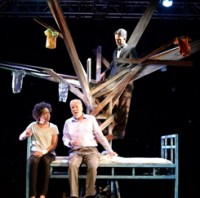
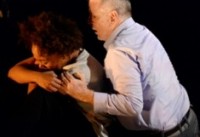
Foreman and Jeff Paul are Diana and Dan Goodman, a middle-aged married couple who would, on the surface at least, appear to be heading “the perfect loving family.” Sure, as Diana sings in “Just Another Day,” “my son’s a little shit, my husband’s boring, and my daughter, though a genius, is a freak,” but what family is perfect? Dan, Diana, Gabe (Alexander Pimentel), and Natalie (Maddie Larson) would seem to be living the all-American dream, that is until you scratch a little deeper and discover some very big cracks indeed.
That Diana is battling bipolar disorder is something we begin to suspect a few minutes in, from the moment she begins to scatter slice upon slice of bread … on the kitchen floor, the better to speed up sandwich prep for husband, son, and daughter. No, indeed, something isn’t quite right at the Goodmans’.
“Zoloft and Paxil and Buspar and Xanax… Depakote, Klonopin, Ambien, Prozac…” are just some of the prescription meds Diana has been prescribed by Dr. Fine (Roberto Alcaraz), as we learn in “My Psychopharmacologist And I,” drugs which may have lessened Diana’s anxiety, but have left her with headaches, blurry vision, and no feeling in her toes. A dosage adjustment does manage to reduce Diana’s delusions, but it worsens her depressive state. Another adjustment leaves Diana with “absolutely no desire for sex, although whether that’s the medicine or the marriage is anybody’s guess.”
While Dan does his best to hold his house together, and seventeen-year-old golden boy Gabe brags in song that today, as always, “the world will feel my power and obey,” aspiring pianist Natalie, a year Gabe’s junior, has only her music to maintain her relative stability, that and the attentions of head-over-heels classmate Henry (Michael Barnum), convinced that although he “might be lazy, a loner, a bit of a stoner, it’s true” he “might be perfect, I’ll make myself perfect… perfect for you.”
Meanwhile, missing “the mountains, the dizzy heights, and all the manic, magic days, and the dark, depressing nights” and encouraged by Gabe, Diana decides to go it alone, sans shrink, sans drugs, sans annoying side effects, and flushes each and every one of her pills down the toilet.
It’s about this time that Henry gets invited to his first dinner at the Goodmans’ … and Next To Normal book writer Yorkey drops a bombshell that causes us to reevaluate all we’ve come to believe about this next-to-normal family—and we’re still only about twenty minutes into the show.
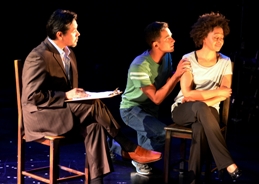 As thoroughly as any other Broadway hit in recent memory, Next To Normal demonstrates just how far “musical comedy” has come since Rodgers & Hammerstein redefined it back in 1944 with Oklahoma! As deep and dramatic and compelling as the best-written contemporary two-act play, Next To Normal takes the often overblown “sung-through” musical (think Evita, Les Miz, Miss Saigon, and Cats) and scales it down to an intimacy that would work equally well on a 99-seat stage as on a 1000-plus-seat regional stage. Add to that a score by composer Kitt and lyricist Yorkey that combines rock rhythms, catchy melodies, and clever, insightful lyrics, and you’ve got a musical that will leave you entertained, shaken, better informed about mental illness, and profoundly moved.
As thoroughly as any other Broadway hit in recent memory, Next To Normal demonstrates just how far “musical comedy” has come since Rodgers & Hammerstein redefined it back in 1944 with Oklahoma! As deep and dramatic and compelling as the best-written contemporary two-act play, Next To Normal takes the often overblown “sung-through” musical (think Evita, Les Miz, Miss Saigon, and Cats) and scales it down to an intimacy that would work equally well on a 99-seat stage as on a 1000-plus-seat regional stage. Add to that a score by composer Kitt and lyricist Yorkey that combines rock rhythms, catchy melodies, and clever, insightful lyrics, and you’ve got a musical that will leave you entertained, shaken, better informed about mental illness, and profoundly moved.
Director Gordon’s most innovative departure is in taking Next To Normal out of its cookie-cutter two-story suburban-home setting and transporting it into the more abstract territory of Diana’s mind, aided and abetted quite ingeniously indeed by scenic designer Elizabeth Smith.
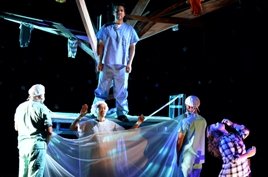 A tree grows centerstage, its branches sky high, a double bed sprouting from its trunk about halfway up. This allows Gordon and her players considerable room to “explore” Diana’s mind to strikingly visual effect. Smith’s design keeps Gabe an ever-present observer to what is going on below, the significance of which will become clear about a quarter-hour in, give or take five minutes, as will the toddler outfits hanging from various branches. The use of white confetti-like paper chits as Diana’s pills in another powerfully visual Gordon touch. The director approaches Next To Normal like a play, seamless transitions from song to dialog and back again leaving no room for traditional musical theater applause, though just about every song rendition merits cheers.
A tree grows centerstage, its branches sky high, a double bed sprouting from its trunk about halfway up. This allows Gordon and her players considerable room to “explore” Diana’s mind to strikingly visual effect. Smith’s design keeps Gabe an ever-present observer to what is going on below, the significance of which will become clear about a quarter-hour in, give or take five minutes, as will the toddler outfits hanging from various branches. The use of white confetti-like paper chits as Diana’s pills in another powerfully visual Gordon touch. The director approaches Next To Normal like a play, seamless transitions from song to dialog and back again leaving no room for traditional musical theater applause, though just about every song rendition merits cheers.
Other design elements—Cara Baker’s costumes, Toranj Noroozi’s lighting, Cricket S. Myers’ sound, Narges Noroozi’s props, and Vicky Tajeb’s makeup and hair—all contribute to giving the production a thoroughly professional air. (Cal Rep is comprised primarily of graduate students, faculty, and staff from the Theatre Arts Department at California State University, Long Beach.)
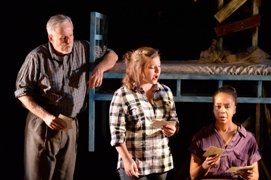 Musical director Jarod Sheahan plays piano in Next To Normal’s three-piece band (Shane Savala on guitar and Greg Erskine on percussion), about half the original’s number, but more than adequate for the Royal’s relative intimacy. Performers’ vocals are only slightly amplified, giving the production a refreshingly “unplugged” sound.
Musical director Jarod Sheahan plays piano in Next To Normal’s three-piece band (Shane Savala on guitar and Greg Erskine on percussion), about half the original’s number, but more than adequate for the Royal’s relative intimacy. Performers’ vocals are only slightly amplified, giving the production a refreshingly “unplugged” sound.
Above all, it is Forman’s powerful, deeply felt performance that provides the very best reason to catch Next To Normal in this non-traditionally cast production, one that begs the question: Why doesn’t this out-of-the-box casting take place more often? Forman combines exquisite vocals and topnotch acting chops to give us Diana in all her complexities and contradictions—her feistiness, her fears, her vulnerabilities, her joys, and her profound sadness. It is a star performance and one not to be missed. (If only Foreman were given the individual curtain call the role and her performance deserves.)
Paul’s Dan may be more time-worn than the book’s timeline indicates, but the stage vet brings both depth and authentic feeling to the role. As for Larson’s Natalie, though the talented young performer could reveal a bit more of the overlooked teen’s smoldering anger and pain, hers is a lovely performance, particularly in scenes opposite Henry, played by Barnam in thoroughly winning fashion, a nerd-as-mensch that any teenage musical prodigy would be lucky to have as her prom date. Alcaraz is a dynamic presence as both of Diana’s doctors, and like his costars reveals first-rate vocal chops.
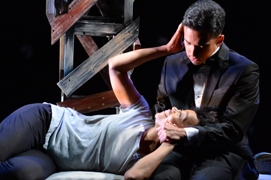 Best of all among supporting players is charismatic newcomer Pimentel, his Gabe a homecoming king with a dangerous edge. Pimentel’s stellar vocals and the abundant athleticism required by Gordon’s staging are two more reasons to declare the recent LAMDA grad “one to watch.” (A pair of beautifully choreographed Gabe-Diana dance sequences are performed by Pimentel and Foreman to heartrending effect.)
Best of all among supporting players is charismatic newcomer Pimentel, his Gabe a homecoming king with a dangerous edge. Pimentel’s stellar vocals and the abundant athleticism required by Gordon’s staging are two more reasons to declare the recent LAMDA grad “one to watch.” (A pair of beautifully choreographed Gabe-Diana dance sequences are performed by Pimentel and Foreman to heartrending effect.)
Daniel Nakawatase is assistant director. Katie Speer is stage manager. Andre Garner is swing coach. (Swings Ian James and Sarah Kennedy will be playing Henry and Natalie on April 30 and May 3.)
A hybrid student/professional production (and one that benefits enormously from its leading lady’s extensive Equity credits), Cal Rep’s Next To Normal is that rarity: a musical that high schoolers, university-aged young adults, and those decades their senior, can enjoy and be moved by in equal measure. It is well worth a visit to the Queen Mary.*
*Cal Rep’s website is frustratingly vague on details regarding the Queen Mary’s Royal Theater. Here’s what you need to know. The theater entrance is accessed from outside the ship, at the Queen Mary’s aft. A ticket, therefore, does not allow access to the ship. However, for $15 you can get a dining voucher to be used in the ship’s several restaurants and bars that will allow you to stroll about the legendary ocean liner. A Cal Rep parking validation helps make Queen Mary parking a bit more affordable, and at a mere $25 for the general public, individual tickets are as affordable as it gets for musical theater of this caliber.
California Repertory at the Royal Theatre aboard the Queen Mary, 1126 Queens Highway, Long Beach.
www.calrep.org
–Steven Stanley
April 22, 2014
Photos: Keith Ian Polakoff
Tags: Brian Yorkey, California Repertory, CSULB, Los Angeles Theater Review, Next To Normal, Tom Kitt

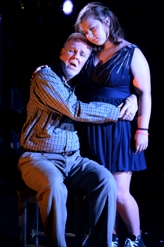
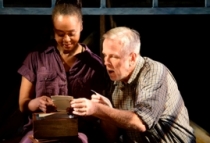

 Since 2007, Steven Stanley's StageSceneLA.com has spotlighted the best in Southern California theater via reviews, interviews, and its annual StageSceneLA Scenies.
Since 2007, Steven Stanley's StageSceneLA.com has spotlighted the best in Southern California theater via reviews, interviews, and its annual StageSceneLA Scenies.







 COPYRIGHT 2025 STEVEN STANLEY :: DESIGN BY
COPYRIGHT 2025 STEVEN STANLEY :: DESIGN BY